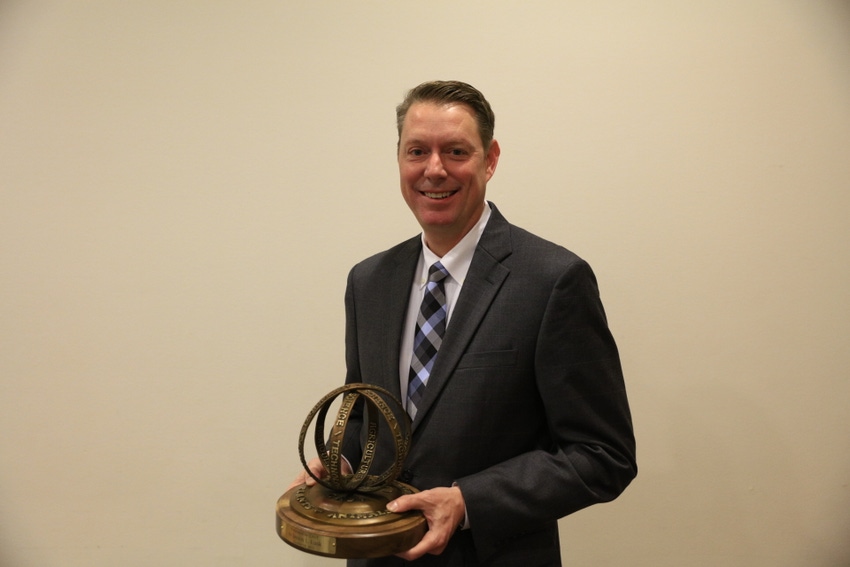October 24, 2017

Each year for the past eight years, the winner of the Borlaug CAST Communication Award has been honored at the World Food Prize International Symposium in mid-October. The CAST award goes to an individual for his or her efforts to bridge the gaps between agriculture and consumers.
This year’s winner is Jayson Lusk, a distinguished professor and head of the ag economics at Purdue University. When presented the award at a World Food Prize event last week in Des Moines, he gave an insightful keynote address about The Future of Food.
The annual award is presented by the Council for Agricultural Science and Technology (CAST) based in Ames, Iowa. It goes to science and ag experts who demonstrate an ability to communicate through written material, public presentations and various forms of media.
“Jayson Lusk is a consummate communicator who promotes ag science and technology in the public arena using multiple forms of media to advocate for science,” said Kent Schescke, executive vice president of CAST.
Effectively communicating ag issues
Lusk’s blog explores how innovation and growth in agriculture are critical for food security and global progress. His most recent book, “Unnaturally Delicious: How Science and Technology Are Serving Up Super Foods to Save the World,” explains how science and innovation are linked in feeding the growing global population. As one nominator wrote, “Lusk is an excellent columnist and blogger. His perspective is often surprising, and he engages the reader.”
After he was presented the award, Lusk shared his thoughts on some challenges and possible solutions he sees in effectively communicating with the public on agricultural issues today.
• An often-heard statistic. “The world population will grow to more than 9 billion people by 2050. And then we hear that farmers must increase yields and productivity to feed this increasing world population. While this message helps motivate farmers, it’s not effective in trying to connect with consumers,” says Lusk. “When we are communicating this message inside the U.S., it’s going to people who, for the most part, don’t buy it because our population in the U.S. isn’t growing. The problem is real for low- and middle-income countries, but communicating that message to people who control the agenda, such as in the U.S., is difficult.”
• There is indeed a growing gap. “The number of consumers of food is increasing and the number of farmers who grow it is decreasing,” says Lusk. Today, 7.5% of the farms in the U.S. produce 80% of the output, according to USDA. He explained that he interprets data carefully to communicate messages that consumers can understand.
• Income makes a difference. The richer a country is, the lower the percent of income its people spend for food. In the U.S. people spend 10% or less of their income for food; poor countries spend 40% to 60% of their income for food. “Yet, it’s the folks on the richer end of the spectrum who set the framework for food policy issues and influence media discussions about what’s important for agriculture,” says Lusk.
Lusk recently conducted a survey of consumer demand. It shows higher-income earners are more concerned with the “naturalness” of foods, along with nutrition and origin. Lower-income earners are more concerned about price, safety and taste.
• Focus on the values held by your audience. Countries with higher incomes have populations that aren’t increasing, or may even be declining in some cases. Low and middle income countries, however, have rising populations. “We certainly need to feed the world, but it’s going to be hard for people in rich countries to feel the urgency to do so,” says Lusk.
Instead of talking about population growth, Lusk suggests focusing on the values that matter most to your audience. “How you tell agriculture’s story makes a difference,” he notes. “Talking in terms of the values held by urban consumers, for example, would be discussing such things as environment, nutrition and what farmers do to help protect and preserve nature. We need to talk about the new technology and practices we use to make food more nutritious and to help farmers take better care of the environment.”
Take it to farmer, public
At the Borlaug CAST Award presentation breakfast, sponsored by Syngenta, Julie Borlaug Larson spoke about her grandfather’s legacy and connections with CAST. She pointed out that the late Norman Borlaug’s words ring true today as much as ever. She praised Lusk for his communication abilities and encouraged everyone involved in communicating for agriculture to “take it to the farmer, take it to the public.”
Dr. Helen Jensen of Iowa State University formally introduced Lusk, who began his presentation by saying he wanted to prove “an ag economist can be an effective and stimulating communicator.” He spoke of the need to consider the emerging food movement and how to engage consumers who mistrust technology and innovation.
Lusk pointed out that productivity and sustainability have improved agriculture with technology advancements such as precision farming tools and genetic engineering. Using facts and surveys, he showed that precision agriculture benefits everyone. He then re-emphasized the importance of considering consumers and their values when communicating with the public. In an era of misinformation and polarization, Lusk is optimistic about “the future of food.”
For more information about the CAST award, visit cast-science.org.
About the Author(s)
You May Also Like






